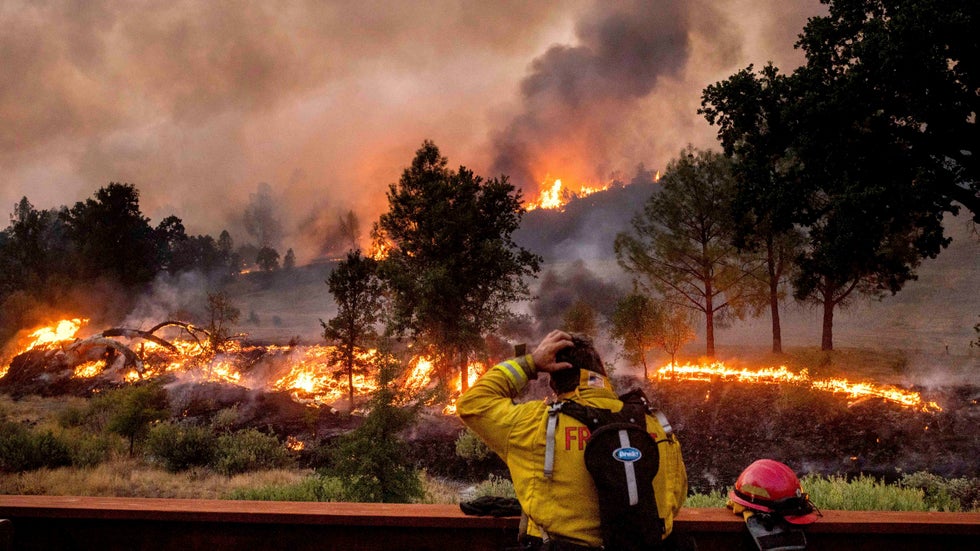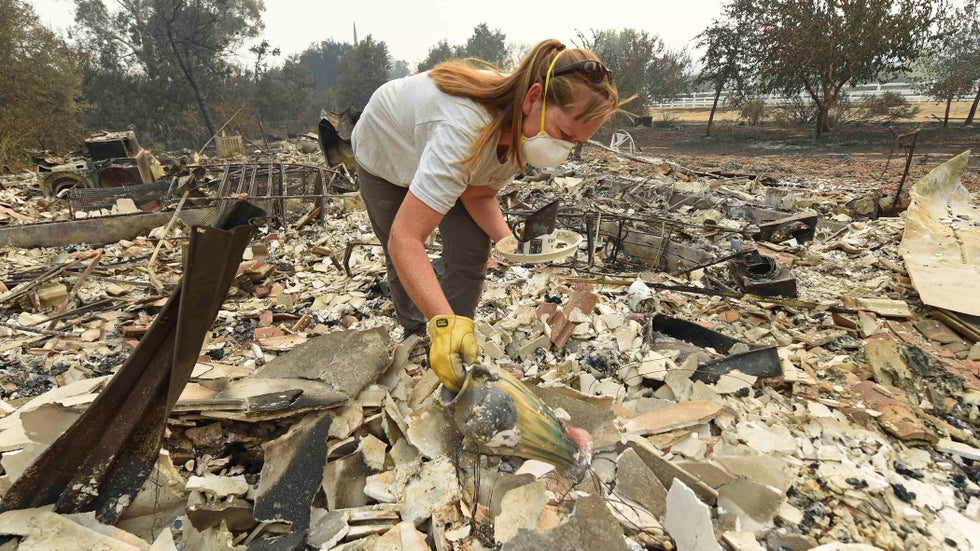California's LNU Lightning Complex Fire, the second-largest wildfire in California history, triggered new evacuations as it continued to grow Saturday.
The fire is also the most destructive of the hundreds of blazes burning in Central and Northern California. The new evacuations were issued for communities in Lake County, California, and warned of "an immediate threat to life."
As of Saturday, the LNU Lightning Complex had burned more than 490 square miles and was 15% contained. At least 560 structures have been destroyed and another 125 damaged. Cal Fire spokesman Scott Ross told weather.com Friday morning that most of the burned structures were homes.
Ross said 70,000 evacuation notices had been sent out to area residents.
At least four deaths are being blamed on the LNU Lightning Complex. Three people died in Napa County and one in Solano, according to Cal Fire. Separately, a Pacific Gas & Electric worker died while responding to the fire, but a cause of death wasn't immediately clear.
In total, the fires across the state have killed at least five people, forced tens of thousands to flee their homes, destroyed more than 600 buildings and left surrounding communities covered in a shroud of dangerous smoke and haze.
Earlier on Saturday, President Trump approved a major disaster request from California Governor Gavin Newsom, opening the door for additional aid for residents suffering from hundreds of fires, including two of the largest in the state's history.
The Presidential Major Disaster Declaration provides opportunities for housing, crisis counseling and more to affected residents.
The National Weather Service issued a fire weather watch for the San Francisco Bay area starting at 5 a.m. PDT Sunday and running through 11 a.m. PDT Tuesday. Lightning – which started many of the current fires – along with gusty winds are of primary concern those days.
San Jose Mayor Sam Liccardo warned residents of some neighborhoods to "have their bags packed" in case of an evacuation order, the Mercury News reported.
Unhealthy levels of particulate matter, the worst type of air pollution, were detected in the air in several areas, prompting warnings for residents to stay inside.
 A firefighter rubs his head while watching the LNU Lightning Complex fires spread through the Berryessa Estates neighborhood of unincorporated Napa County, California, on Friday, Aug. 21, 2020.
A firefighter rubs his head while watching the LNU Lightning Complex fires spread through the Berryessa Estates neighborhood of unincorporated Napa County, California, on Friday, Aug. 21, 2020.(MORE: Coronavirus is Changing the Way Wildfires are Fought)
The LNU Lightning Complex is one of three large clusters of fires burning in Northern and Central California.
Another one, named the SCU Lightning Complex, has charred more than 450 square miles and destroyed five buildings in Santa Clara, Alameda, Contra Costa, San Joaquin and Stanislaus counties, and was 10% contained. On Saturday, it grew to the third-largest wildfire in state history.
A third cluster of fires in San Mateo and Santa Cruz counties destroyed nearly 100 buildings and forced some 77,000 people to evacuate. Those blazes, called the CZU August Lightning Complex, have burned more than 98 square miles and were 5% contained as of Saturday morning.
San Mateo County beaches closed for the weekend in order to cut down on traffic that could impede emergency vehicles, according to the Mercury News.
Flames from the CZU complex destroyed much of Big Basin Redwoods State Park, the oldest state park in California. The park's headquarters, historic core area and campgrounds all sustained extensive damage, according to a news release.
The Santa Cruz Civic Auditorium, one of the main evacuation shelters for the complex, has reached capacity, according to KGO-TV. Ross told weather.com Friday morning that hotels in areas where fires were burning were also full.
 Sarah Hawkins, of Vacaville, finds a vase in the rubble after her home was destroyed by a fire in Vacaville, California, on Thursday, Aug. 20, 2020.
Sarah Hawkins, of Vacaville, finds a vase in the rubble after her home was destroyed by a fire in Vacaville, California, on Thursday, Aug. 20, 2020.The three large fire clusters have consumed more than 1,000 square miles of land and destroyed at least 550 buildings. Those figures don't include several other individual fires burning around the state.
Like the LNU complex, most of them were started by lightning strikes amid a record-breaking heat wave and ongoing drought conditions.
More than 30 firefighters and civilians have been injured. A helicopter pilot was killed in a crash while fighting a fire in Fresno County on Wednesday. At least two people were missing among the fires, the Associated Press reported.
Some families lost everything to the unrelenting flames of the LNU complex.
"I'm sick to my stomach, I don't really have words," Laura Souza, who evacuated with her family from their home in Solano County, told KOVR-TV.
Souza hadn't been able to get back into her neighborhood yet, but she's seen video. Her home is a charred ruin, flattened by the flames.
"It's devastating," she said.
The fires that make up the LNU complex started earlier this week. Several merged together on Thursday as the land area on fire exploded in size.
Communities in and around San Francisco, including Gilroy, Berkeley and San Jose, were clouded in a shroud of brown smoke from the fires, prompting air quality alerts for residents.
Fire officials said a "lightning siege" of more than 11,000 strikes sparked 367 fires across California this week. NOAA satellites produced a time-lapse of all the strikes.
Joseph Dwyer, a physicist and lightning researcher at the University of New Hampshire, told the New York Times that much lightning in such a short time is rare in California, where a total of 85,000 strikes are typically recorded in an entire year.
The Weather Company’s primary journalistic mission is to report on breaking weather news, the environment and the importance of science to our lives. This story does not necessarily represent the position of our parent company, IBM.
The Weather Company’s primary journalistic mission is to report on breaking weather news, the environment and the importance of science to our lives. This story does not necessarily represent the position of our parent company, IBM.

No comments:
Post a Comment